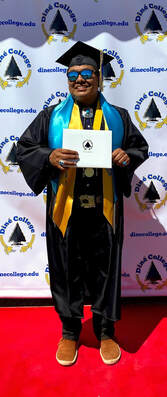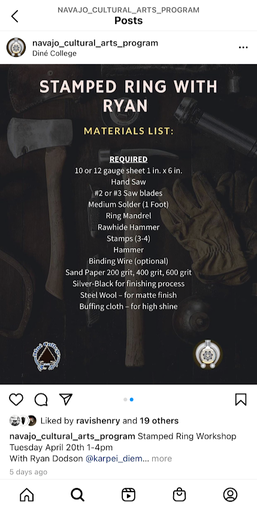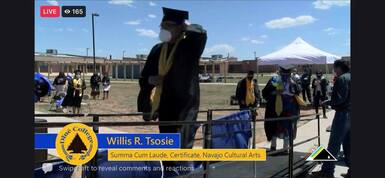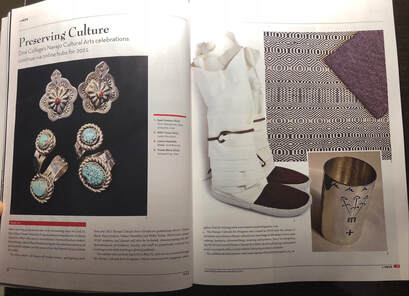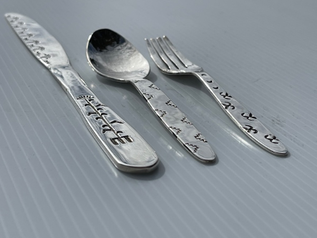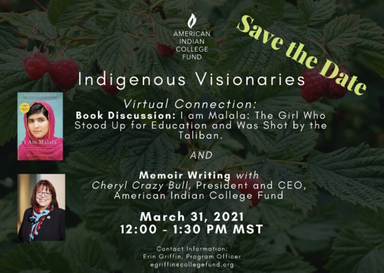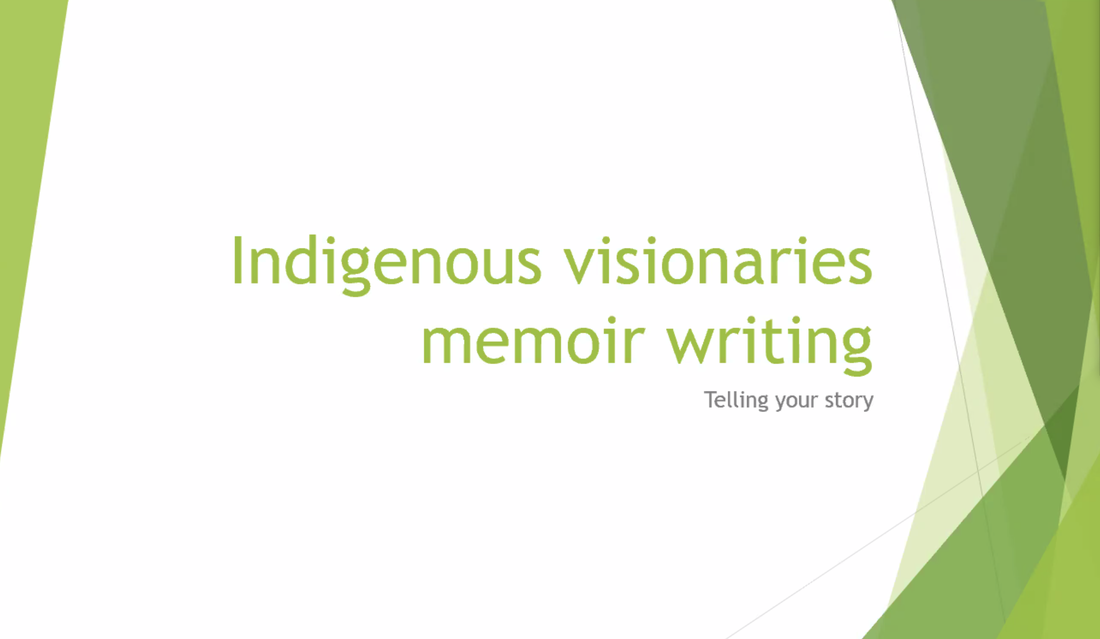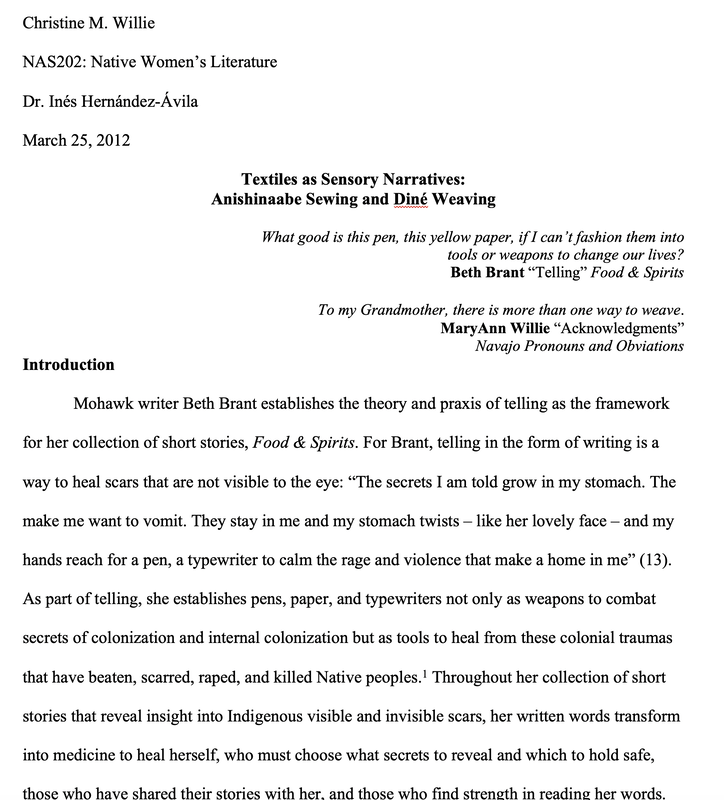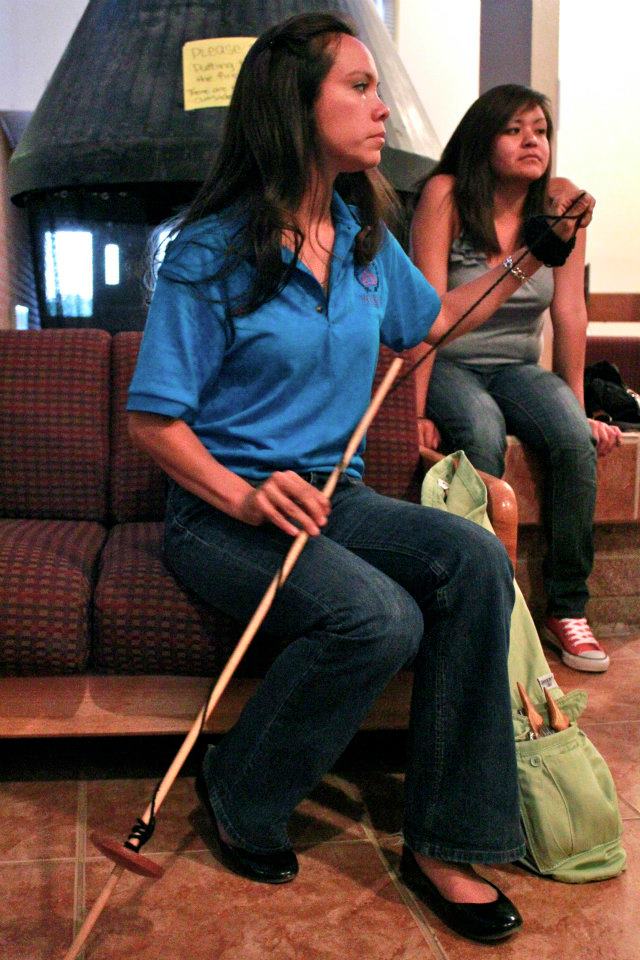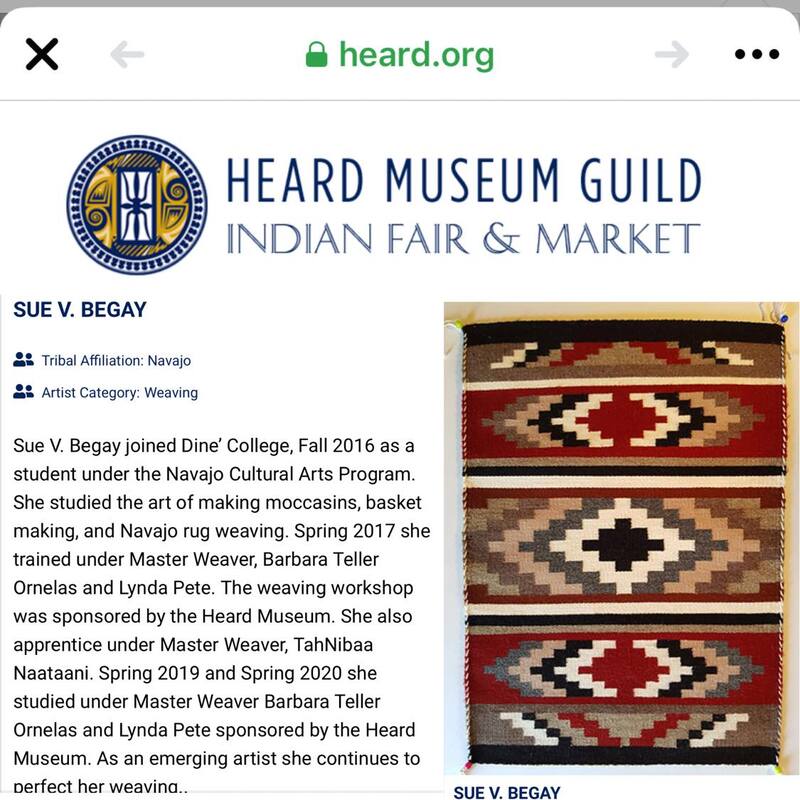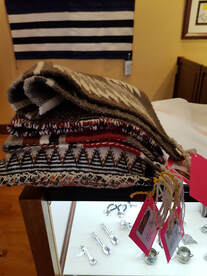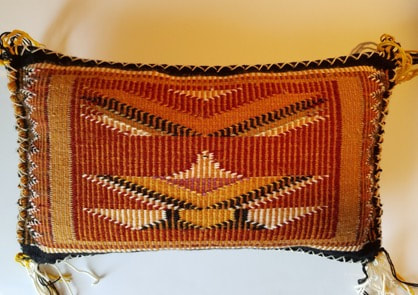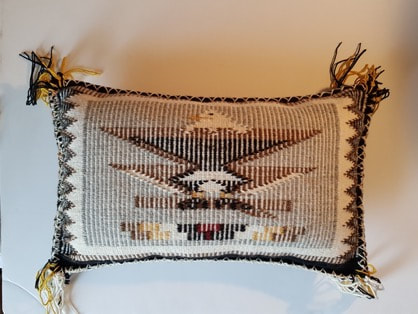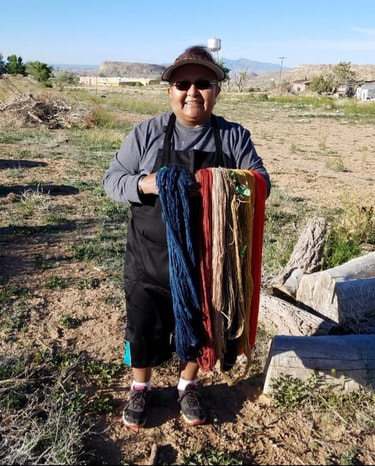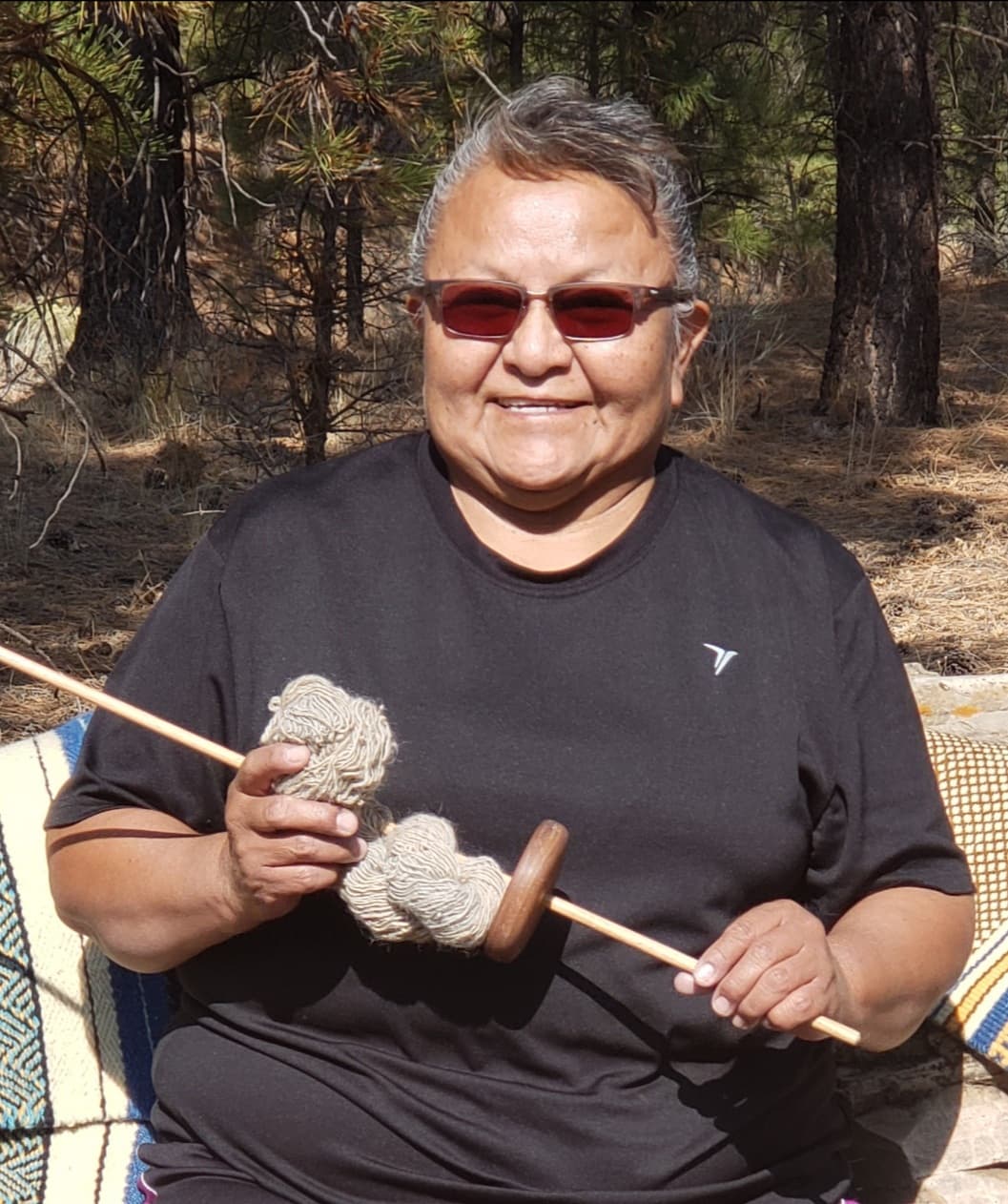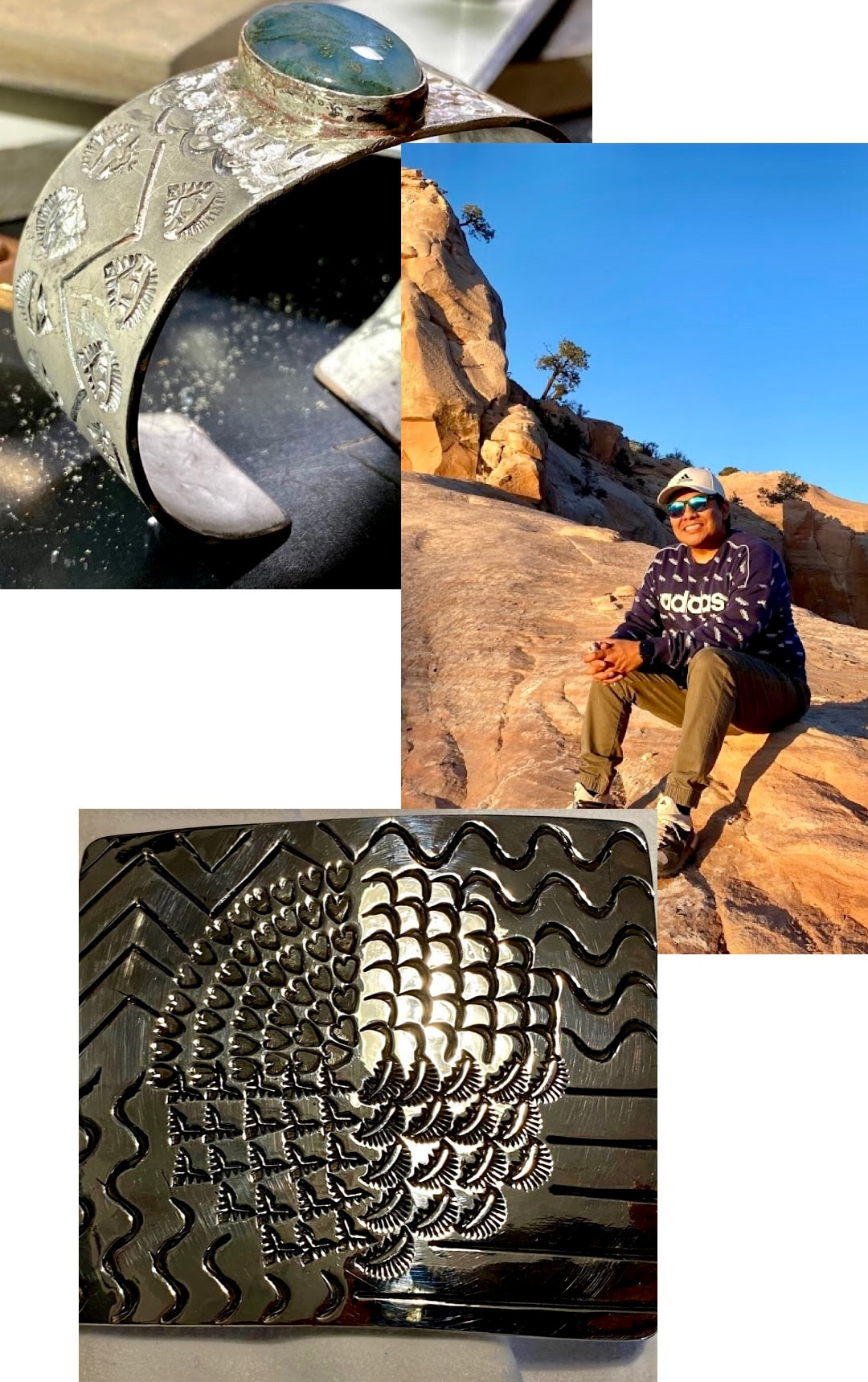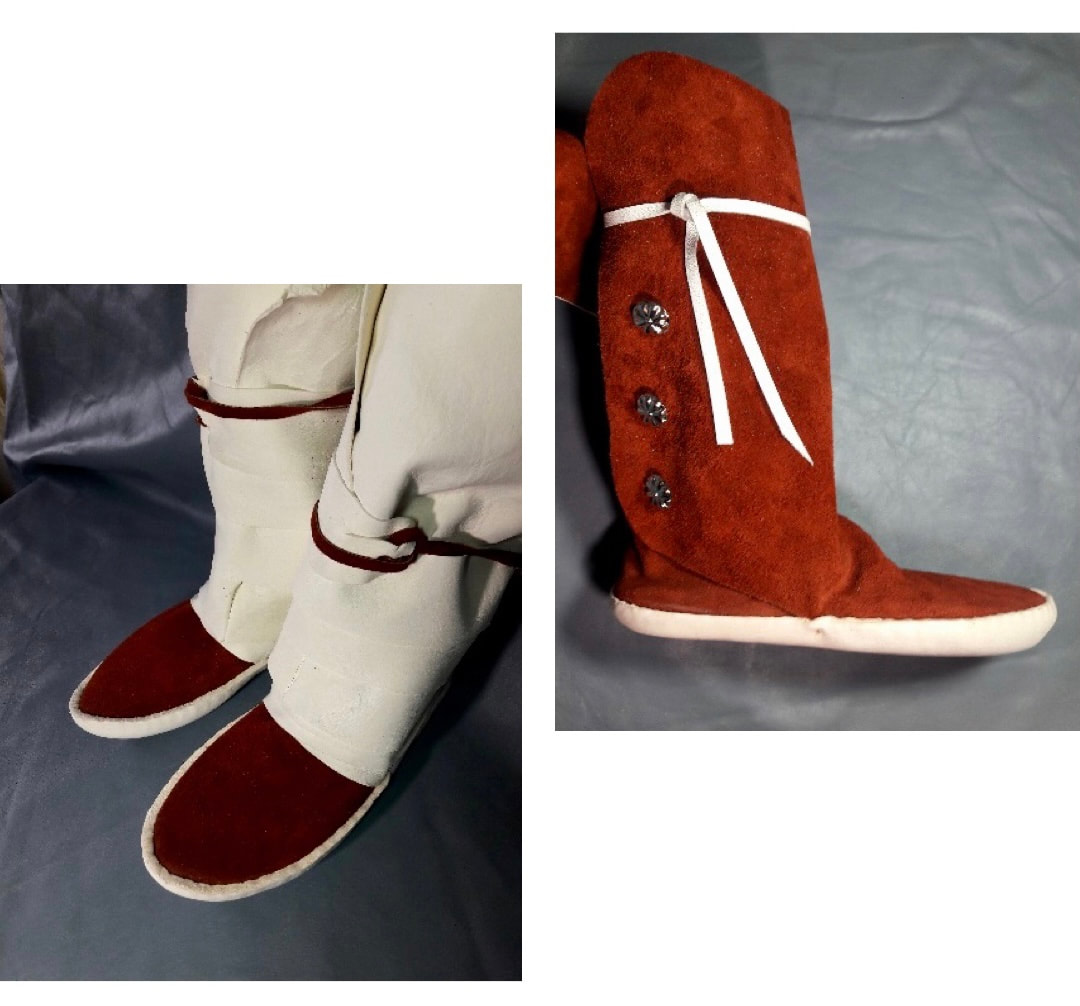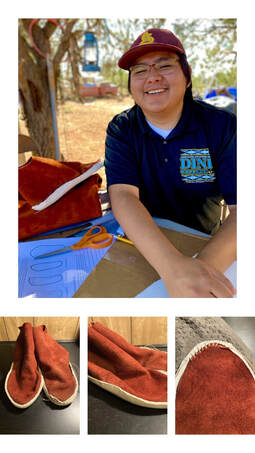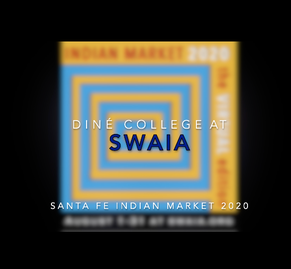Ryan DodsonNavajo Cultural Art Certificate, 2020-21, Silversmith
Since I was young, my parents instilled in me the importance of getting an education. They explained that my education would provide for me in ways that I never imagined. This is most telling in my recent educational endeavor at Diné College.
Amid our global pandemic, I was challenging myself to adapt to the unprecedented circumstances that many students were facing. I am not claiming that it was easy - the first time my hammer struck silver was intimidating. However, finding it within myself to be confident in each hit of the hammer allowed me to live in the moment. I like to think of myself as a planner and my meticulous attention to detail has allowed me to create events within my job title to be successful. But that type of personality always has me thinking 3-4 steps ahead, never really just sitting in the moment. So, this past year, as I sat at my bench looking at the silver, taking deep breathes, and connecting with my hammer. With each stamp impression, I found myself living in the moment. My mind was not consumed by the future. It was a new phenomenon. I was hooked. Over the course of the certificate program, the renewed and revitalized attitude about my culture has been the biggest benefit. My instructors embraced Navajo culture and taught, unapologetically, what it will take to be a successful student at Diné College. This has provided balance and harmony back into my life and all it took was some silver and my own creative imagination.
0 Comments
Willis TsosieNavajo Cultural Arts Certificate Student, Moccasin Maker
although with new practices: Each graduate was only allowed two guests due to CDC restrictions, temperatures were taken and vaccination cards checked before we were allowed onto campus grounds. As the 2021 Diné College Commencement Exercise was being carried out, my mind started reflecting on how I got here - ready to accept a certificate in Navajo Cultural Arts and sharing this experience with two of the most important people in my life who were seated next to me. Despite all of the new measures, for me, this year was even more different that the rest - this year I was a student. You see, I have already completed course requirements at the graduate level. With my Master's Degree I teach mathematics here at Diné College. But this certificate really meant something to me personally because every aspect about NCAP was one hundred percent Navajo. The courses (content and materials), the educators, the personnel, and the location, all Navajo Thinking about today's epic graduation, during the taming of a pandemic, I realized that I walked across the same stage as many of my students. I also thought about all my Navajo cultural arts educators in moccasin making and silverwork. Here at Diné College, our cultural arts teachers are often grandparent or even great-grandparents, all with decades of knowledge and wisdom from years before them. And now they continue to share their artistry through me. I was fortunate to have such patient people teach me the importance of understanding the connection between the pieces I’m making to Navajo origin stories, ceremonies, songs, and prayers.
Returning to my seat, where my family waited for me after I received my Navajo Cultural Arts Certificate, I thought about the lesson in Dzil Biyiin (Mountain Song) where it talked about a personal decision you make to embark on a journey that may require perseverance, strength, endurance, and purpose. The journey is like the thought of going to a mountain, traveling to the mountain, reaching the mountain, climbing the mountain, reaching the top of the mountain, and descending down the mountain. And just about every stage of your journey may have obstacles, and to resolve them may require critical thinking and decision making. Even when you reach the top of the mountain (Bikaa’ Ha’seya’), you have to decide what your plans are for the future, what are your hopes, dreams, and expected accomplishments. My journey was to complete the NCAP Program. Triston BlackNavajo Cultural Arts Certificate, Emphasis Area: Silversmithing
Béésh Łigaii Yitsidí makes you use the process of Nitsáhákéés, Nahat’á, Iiná, dóó Siih Hasin.
It is all part of the learning process, so throughout your experience you discipline yourself to improve yourself as an artisan and the pieces you create. In return, silversmithing disciplines you and your pieces create you.
Don’t be afraid of the metal or hammer when stamping, get the feel for it and your hammer will recognize you as a person. Talk to the metal about your intentions, then the metal knows your purpose and will work with you. That is what I have come to learn as an emerging artisan. Once you get the hang of it, then your Diné mind will create unique and special constructions. You have the potential of using your Diné mind, you just got to open it and you can run with it. Dr. Christine AmiNCAP Grant Manager and 2020/21 American Indian College Fund Indigenous Visionaries Mentor March 31, 2021: I couldn't image a better last day of National Women's History Month than with a book discussion on I am Malala followed by a memoir writing workshop with none other than the president of the American Indian College Fund, Cheryl Crazy Bull!
Throughout our Virtual Connection, we had the opportunity to hear from several of the other Indigenous Visionaries fellows from: Fond du Lac Tribal and Community College and Salish Kootenai College. We touched upon some key points and personal connections with the text. I was particularly impacted by commentary from our own NCAP Visionary, Tammy Martin, who pointed out that she read the story of Malala, a young girl who was shot by the Taliban for advocating for eduction, through the eyes of young Nobel Peace Prize winner's parents. Our discussion moved from takes on feminism to the power of writing for women. One of our College Fund facilitators brought forth a quote from the reading that highlights the act of writing as activism. Malala writes:
I know, I know - I am getting a bit jargony here - but hang with me for a sec or two... Specifically, Spivak highlights: "Can the subalern speak? What must the elite do to watch out for the continuing construction of the subaltern? The question of 'woman' seems most problematics in this context" (90). Through her critical eye of Foucault and Deleuze, she concludes: "The subaltern cannot speak. There is no virtue in global laundry lists with 'woman' as a pious item. Representation has not withered away. The female intellectual as intellectual has a circumscribed task which she must not disown with a flourish" (104). So the question remains - how does the intellectual, even the female intellectual, represent these voices without being condescending, without commoditizing their knowledges and their experiences, without engaging with epistemic violence of academia? For Malala the answer is clear, don't wait for the academic - write for ourselves. Just as my mind started to wonder further into memories of literary theory and gender studies lectures, inquiries of what/who defines an "intellectual", and the complexities of my role as a Navajo woman with a Ph.D. in academia, our Indigenous Visionaries event flowed into a memoir writing workshop - I see what you did there, College Fund people... read a memoir, workshop our own memoirs ;)
You see, I write in stories - a highly controversial form of data delivery in the academic realm - second reader responses typically echo: where is the hypothesis?; is this the introduction?; why can't you just get to the point?; is this creative writing?, is it theory?, is this even research? My introductions are usually snapshots of when the perplexities of the study have culminated in a personal setting and my conclusions are usually finalized with my traditional introduction, reaffirmations of who I am as a Navajo woman. In between are hypotheses, data, theory and research. More importantly, these stories from my experiences, from my studies - both formal and informal - are how I learned to learn and how I learned to teach. From weaving to butchering, from graduate papers to my dissertation, from to my response to the Navajo Nation's president for silencing me to my current application for a National Endowment of the Humanities Grant - stories are where you will find my voice, my successes, my failures, my family - it is where you will find me. So vulnerability pretty much wraps up a lot of my anxieties about publishing. Cheryl pushed those vulnerability buttons and had us practice some writing - "How does your story start?" What better time to test out the starting line to my article draft, entitled: "A Native Scholar Pushing Back: Epistemological Imperialism, Academic Gaslighting, and Credential Theft". What would people say? What would my peers think? Despite the fact that the group I was writing with could not have been more supportive, vulnerability creeped in. Oh well... here I go: In the stillness of my home before the sun rose, before my children, husband and animals awoke, I was trying to make sense of the theft of my Indigenous research credentials by a non-Native former colleague. Heads nodding - That's a good zoom sign. A voice reached out: "I would read that!" Another voice followed, "Yeah, I would too." Followed by another, "Now, I want to know what happened!" Validation of my experience, of my voice, of not only others hearing me - but of others listening to me. It was only the first sentence and the story was still to come, but it was an opening line that epitomized a crucial moment in my life as an academic and a Native woman and which also interwove my experience in complex sociopolitical realities of the Native American Studies discipline. After our workshop, I thought about what was shared and what it means for a Native American Woman to write down her stories. My fingers reached for one of the first Native women's anthology that I had ever read, Reinventing the Enemy's Language (1997). Julia Coates, Councilor for the Cherokee Nation's Legislative Branch, and my first Native Women's Literature professor at UC Davis, introduced me to this compilation of poems, songs, and essays that bring to life the "beautiful survival" of Native women, including all of the ugly as Joy Harjo declares: "We are still here, still telling stories, still singing whether it be in our native language or in the 'enemy' tongue" (31). As my mind returned to the issues brought forth by Spivak, these questions returned: How can I write about Navajo women, from my position as an academic, and encapsulate their voice with mine? And then I thought - why do I have to encapsulate ALL Navajo women and why do I have to write like a western academic? What I write about is my experience as a Navajo woman and I write in stories.
These sensory textile narratives constitute creative acts of writing, complicate constructions of Indigenous feminisms, and promote cultural sovereignty through means other than the enemy’s language. And as I thought of those words and my place in academia, I thought of my grandmother. I thought of how she told me stories - it was through weaving. Weaving is our memoir - In the warp are stories of her survival and mine. Each line is a recap of my day, smooth hooks retell my successes, each section unwoven is not only the presentation of one of my failures but also my reattempt at troubleshooting the problem at hand. Inside my weavings are my thoughts - my family - my research - my vulnerabilities. Inside my weavings are told, unseen stories. I haven't woven a complete piece in years - work and life have kept my loom covered. I tried to look at my weaving tools that were my nálí's who passed away from COVID complications in July. But I just wasn't ready. But today - today is different. Today I picked up my spindle. The warp, my hand, my thigh became one instrument. My spit used to mat and settle the warping mixed with the wood of the spindle and in return that taste of wood brought forth the memory of the feel of my nálí's velveteen skirt - coated with a slight tinge of mutton grease. The sound of my spindle on the floor joined the sound of her spindle in my memory. Just like that - My grandmother, Cheryl, Gayatri, Julia, Joy, Inés, and I, we started a new piece - In this warp is the outline for my next memoir - this one includes the stories of the Visionary fellows and how they got their mentor to weave once more. It is filled with the vulnerabilities we discussed in our workshop, power that is associated with learning to write ones story, and continuation of our ways of knowing with a weaving comb in hand.
Sue V. BegayWeaving BFA Student, American Indian College Fund Indigenous Visionaries Winter 2021 Fellow
Never once did I think that one day I would be amongst them as an artist. Well, it happened this year. With the encouragement from the Navajo Cultural Arts Program, my Visionaries' mentor, and one of my weaving mentors, Tahnibaa Nataanii, I completed the Heard Guild and Indian Market's application and submitted it. The application process was pretty simple – to be considered I submitted my art descriptions, pictures and paid an application fee. The hard part was waiting to hear if my art was accepted. The anticipation to receive word back as to whether or not I was accepted, waitlisted or rejected was almost too much...I didn't know if I would get it. It takes artists YEARs to get it.... but it came! I was accepted! Sue V. Begay from Dennehotso, Arizona got a spot at the Heard Museum! After I accepted and paid my booth fee, my thoughts were on how exciting and honored it was going to be placed among the super famous artists. Seriously though – Tahnibaa Nataanii, Lynda Pete, Barbara Teller Ornelas – they are my teachers, my friends and I was going to have our work shown next to theirs! I was happy to be amongst them even though it was a virtual experience.
I was elated to sell two of my three weaving pieces. The personal experience is self-achieving with lots of support and encouragement from your peers. If it were not for the support of Diné College programs I would not have had the opportunity to shine with the superstars.
I look forward to submitting again next year. I'll have to apply again and I am sure it will be an entirely unique experience to be selling there in person. A few pieces of advice that I have for my fellow emerging Navajo artists about entering into shows like the Heard Indian Market is:
The pictorial raised edge with an eagle design pillow shown below is one of my items that sold at The Heard. Tammy MartinNavajo Weaving BFA Student, American Indian College Fund Indigenous Visionaries Fellow
She was very happy with her sale because she got to keep the money. This money allowed her to buy graduation items she thought she wouldn’t be able to afford. She went on to attended Navajo Community College (now Diné College) and earned a certificate. She uprooted from her home area and moved to the Eastern Agency community of Crownpoint. It was here that she worked at Indian Health Services, the Navajo Nation Police Department, the Office of Vital Statistics, and Crownpoint Community School. She had married, had a family and a place to call home. Weaving became therapy because she soon found herself a victim to domestic violence. Two years after filing for divorce, her oldest daughter became ill with leukemia and passed away in April. During these trying times weaving de-stressed her and provided an extra income. Five years later, she married Kenneth Begay, a big supporter of Gloria and his stepchildren.
When teaching her students, she tells them to research other well known weavers and their textiles such as Roy Kady, sisters Barbara and Lynda Teller, Gilbert Nez-Begay, and Kevin Aspaas; they all have their own story for weaving, their styles are what makes them recognizable, even from a glance. She says “the more you learn about other weavers, the more you know about yourself and you can create your own style”. Learn your language, even if you know just a few words, you identify yourself as a Diné person; to learn that being Diné is unique. “No one can take that identity from you”. That is something that a lot of our youth are dealing with, they may feel embarrassed to speak it because they might get shamed for speaking; it should be that way, we should be encouraging all the youth to speak our language. The last is something that she recalls her mother sternly telling her “You have ten fingers, those ten fingers are given to you so that you can take care of yourself; work with your hands”. This was not just a saying, it is the Diné philosophy of self determination or T’aa Awoli Bee. I recall my own grandmother saying that whatever you want or desire is at the very tip of your fingers, it's up to you to make the rest of the hand, mind and body to work to earn it. Sometimes, we take for granted how much work you put into something has its own rewards, or sense of accomplishment. We ended the interview encouraging one another to keep weaving, carding, spinning, and learning. In Gloria’s words “Weaving is a non-stop learning process”. Download the full recap of Tammy's interview with Gloria here:
My buckle and two bracelets have unlocked a new area of thinking that I did not know existed! By learning the traditional techniques, I have also discovered that I only need a hammer and a few stamps to create beautiful pieces of jewelry.
In the second semester, I am excited to challenge myself to learn and create pieces of jewelry that speak to my understanding of Navajo Culture. In the meantime, I will continue to let my creativity “flow”.
Yá’át’ééh. My name is Willis Tsosie. Ta'chii'nii – nishli, Ta'neeszahnii – bashishchiin, Kiyaa'aanii – dashicheii, Totsohnii – dashinali. I am from White Clay, near Sawmill. I spent time in Montana where I raised a family, completed my higher education experiences, and learned some lessons about life from Crow elders, like the one I just shared with you.
Considering myself a lifelong learner, I had an interest in learning Navajo silverwork when I returned home to Dine’, and learned the art at Dine’ College. The learning experience was more than using tools and creating pieces, I also learned its cultural meanings, specific protocols, and how creation comes from within. The experience inspired me to learn more about Navajo cultural arts, so I enrolled into the NCAP Certificate Program where I learned the art of moccasin making from a respected Navajo historian and artisan. Mr. Walters would start class with a lecture on a Navajo origin story pertaining to Navajo moccasins. With the lecture completed and students continuing with their current moccasin project, we would soon hear Mr. Walters turned on his favorite music recordings like Glen Campbell or 70s rock from a small cassette player he brought to class. To me, knowing the music was there created an atmosphere of learning, concentration, and collaborating. Similar to some of you who may remember waking up to your mom or grandma talking in the kitchen while making breakfast and listening to a Navajo radio station. And between tapes Mr. Walters would provide a few more lessons on Navajo moccasin making. As a student working towards a certificate program I can explain to you the details involved in making a pair of Navajo moccasins, but as a student embarking on an educational journey, the moments that are captured, like Mr. Walters music will long be remembered and becomes a part of my journey. I think that was what my Crow friend was explaining to me.
My favorite NCAP activity was being able to make my first pair of moccasins, hands down! Coming into NCAP, I didn’t know what to expect or prepare myself for… especially during a global pandemic. I wondered how our classes were going to perform and how I would get the materials but thankfully the staff provided us with the necessary tools to get started. We got out first instructional video and I watched that I don’t know how many times! Our instructor shicheii Harry Walters gave us a step-by-step video and I kept practicing and practicing his every movement. I think by now I remember the video link by heart… that gave me the groundwork in the moccasin making process.
After completing the left side of my first pair, I seen areas where I could improve and better myself for the right side. I took in shicheii Walter’s advice and began making the right side. After 2 hours, I finished shaping the sole and patiently waited for it to form. In the pictures you can see where I reevaluated my performance. After showing shimásání dóó shimá, it made me feel better seeing their facial expressions. Their amazed faces and encouragement stayed with me throughout the effort put in. What do you look forward to as you start the second semester of the Navajo Cultural Arts Certificate Program? To gain more knowledge in traditional forms of processing the hide and tanning. We watched a video dating back to 1945 and I saw families gathering and processing the hide from the cow they butchered. I thought our Navajo people did amazing work and turning their ideas into a usable creation. Christine M. Ami NCAP Grant Manager
Several of our NCAP family members were juried into the in person event prior to its transition to a virtual format. These 4 individuals decided to take the leap with SWAIA into the realm of online sales. We wanted to give a tremendous shout out to our Diné College faculty and students who are now entering into their 4th week of this virtual market: -Pottery Instructor: Jared Tso -Wool Processing Instructor: Tahnibaa Naataanii -BFA Silversmithing Student: Carlon P. Ami II -BFA Silversmithing Student: Ephraim "Zefren" Anderson Click on their names above and you will be routed directly to their SWAIA Artist Page. There you can learn more about them as artists and purchase directly from them via their online booths! While the Virtual Market ends August 31st, the artists' websites will be accessible for an entire year. So stop back in and check on the unique work being produced throughout the next year. Crystal and I also had an opportunity to sit down and have zoom chats with Jared, Carlon, and Zefren about their experiences being accepted into the market and setting up their virtual SWAIA booths. Check out our conversations below!
We look forward to supporting our Diné College artists in their cultural and fine arts pursuits. If you are interested in joining the Diné College Bachelor of Fine Arts Programs, be sure to contact the following program coordinators for more information:
Shaina Nez, BFA Coordinator, shainez@dinecollege.edu Crystal Littleben, Navajo Cultural Arts Program Coordinator, cclittleben@dinecollege.edu |
Categories
All
Archives
October 2021
|
||||||||||||||||||||||||||||||||||||||||||||
SocialsALL PHOTOS IMAGES ARE COPYRIGHT PROTECTED. PHOTO IMAGES USE IS SUBJECT TO PERMISSION BY THE NAVAJO CULTURAL ARTS PROGRAM. NO FORM OF REPRODUCTION IS PERMITTED WITHOUT WRITTEN PERMISSION FROM THE NAVAJO CULTURAL ARTS PROGRAM. |
Featured Pages |

